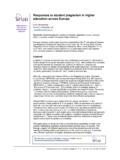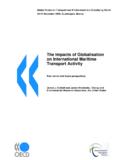Transcription of EDUCATION POLICY OUTLOOK BRAZIL - OECD.org
1 EDUCATION POLICY OUTLOOK BRAZIL November 2015 EDUCATION POLICY OUTLOOK : BRAZIL OECD 2015 2 EDUCATION POLICY OUTLOOK This POLICY profile on EDUCATION in BRAZIL is part of the EDUCATION POLICY OUTLOOK series, which presents comparative analysis of EDUCATION policies and reforms across OECD countries. Building on the OECD s substantial comparative and sectorial POLICY knowledge base, the series offers a comparative OUTLOOK on EDUCATION POLICY by providing analysis of individual countries educational context, challenges and policies ( EDUCATION POLICY profiles), analysis of international trends, and insight into policies and reforms on selected topics. In addition to country-specific profiles, the series also includes a recurring publication. The first volume, EDUCATION POLICY OUTLOOK 2015: Making Reforms Happen, was released in January, 2015.
2 Designed for POLICY makers, analysts and practitioners who seek information and analysis of EDUCATION POLICY that takes into account the importance of national context, the country POLICY profiles offer constructive analysis of EDUCATION POLICY in a comparative format. Each profile reviews the current context and situation of a country s EDUCATION system and examines its challenges and POLICY responses, according to six POLICY levers that support improvement: Students: How to raise outcomes for all in terms of 1) equity and quality and 2) preparing students for the future Institutions: How to raise quality through 3) school improvement and 4) evaluation and assessment System: How the system is organised to deliver EDUCATION POLICY in terms of 5) governance and 6) funding. Some country POLICY profiles contain spotlight boxes on selected POLICY issues.
3 They are meant to draw attention to specific policies that are promising or showing positive results and may be relevant for other countries. Special thanks to the Government of BRAZIL (through its Ministry of EDUCATION and the National Institute for Educational Studies and Research), for its active input during consultations and constructive feedback on this report. We also thank the Funda o Ita -Social for its financial support to make this country profile possible. Authors: This country POLICY profile was prepared by Juliana Zapata (main drafter), Beatriz Pont, Diana Toledo Figueroa, Judith Peterka and Sylvain Fraccola (statistics and design), from the EDUCATION POLICY OUTLOOK team, which is part of the POLICY Advice and Implementation Division, led by Richard Yelland. Elizabeth Fordham also contributed during the revision of this profile .
4 Editorial support was provided by Sophie Limoges and Susan Copeland. This profile builds on the knowledge and expertise of many project teams across the OECD s Directorate for EDUCATION and Skills, to whom we are grateful. Sources: This country profile draws on OECD indicators from the Programme for International Student Assessment (PISA), the Teaching and Learning International Survey (TALIS) and the annual publication EDUCATION at a Glance. It also refers to country and thematic studies such as OECD work on early childhood EDUCATION and care, teachers, school leadership, evaluation and assessment for improving school outcomes, equity and quality in EDUCATION , governing complex EDUCATION systems, vocational EDUCATION and training, and tertiary EDUCATION .
5 Much of this information and documentation can be accessed through the OECD EDUCATION GPS at Most of the figures quoted in the different sections refer to Annex B, which presents a table of the main indicators for the different sources used throughout the country profile . Hyperlinks to the reference publications are included throughout the text for ease of reading, and also in the References and further reading section, which lists both OECD and non-OECD sources. More information is available from the OECD Directorate for EDUCATION and Skills ( ) and its web pages on EDUCATION POLICY OUTLOOK ( ). EDUCATION POLICY OUTLOOK : BRAZIL OECD 2015 3 TABLE OF CONTENTS Highlights .. 4 Equity and quality Improving access to EDUCATION .. 6 Preparing students for the future Increasing educational attainment and developing institutional quality.
6 8 School improvement Fostering teacher quality .. 10 Evaluation and assessment to improve student outcomes Developing accountability .. 12 Governance Decentralised system in which all levels of government drive EDUCATION POLICY .. 14 Funding Increased spending and efforts to distribute funds more equitably across the EDUCATION system .. 15 Annex A: Structure of BRAZIL s EDUCATION system .. 17 Annex B: Statistics .. 18 References and further reading .. 21 Figures Fi gure 1. Performance of 15-year-olds in mathematics .. 5 Figure 2. Upper secondary and tertiary attainment .. 5 Figure 3. Percentage of top and low performers .. 7 Figure 4. Students in EDUCATION and not in EDUCATION , by educational attainment and work status .. 9 Figure 5. School principals' and students' views on learning environment .. 11 Figure 6. Student assessment by purpose.
7 13 Figure 7. Expenditure on educational institutions .. 16 Spotlights Spotlight 1. Increasing access to EDUCATION for the most disadvantaged students .. 7 Spotlight 2. Improving student achievement through better teaching quality .. 11 Spotlight 3. Distributing funds equitably through national EDUCATION development funds .. 16 EDUCATION POLICY OUTLOOK : BRAZIL OECD 2015 4 HIGHLIGHTS BRAZIL s educational context Students: BRAZIL has made significant improvements in mathematics, reading and science across PISA cycles, and the share of low performers has significantly decreased. Average performance on PISA 2012 remained below the OECD average in all three assessments. A majority of 15-year-olds are low performers in mathematics ( , compared to the OECD average of 23%). Compulsory EDUCATION covers ages 4 to 17.
8 Grade repetition ( ) is higher than the average across OECD countries ( ). BRAZIL s attainment rates among 25-34 year-olds are similar to the OECD average in upper secondary EDUCATION (45% in BRAZIL , compared to the OECD average of 42%), and below the OECD average in tertiary EDUCATION (15% , compared to the OECD average of 41% ). A lower share of students in BRAZIL (8% ) enrol in vocational EDUCATION than the OECD average (46% ). About 12% of tertiary EDUCATION institutions are public, and admission is highly competitive. Private tertiary institutions are regulated by the federal government, and access is facilitated through incentive and scholarship schemes, in particular for disadvantaged students. Returns on tertiary EDUCATION in BRAZIL are high compared to OECD countries, and unemployment rates for all attainment levels are below the OECD average.
9 Institutions: Students report good relations with their teachers, while BRAZIL s school disciplinary climate is less positive than the average, according to both students and teachers. Learning environments differ between public and private schools, and this affects student performance. Most schools have three sessions per day (morning, afternoon and evening), and few public school students have full-day schooling. A majority of school principals and teachers in BRAZIL have tertiary EDUCATION and are younger than the OECD average. Efforts have been made to improve teachers salaries, which are below the OECD average. National evaluation and assessment tools consist mainly of international assessments, national standardised assessments and the Basic EDUCATION Development Index, which provide information on system and school performance to government bodies, schools, parents and communities.
10 This information is used to identify challenges, set goals and provide evidence for EDUCATION POLICY . System: The Ministry of EDUCATION is responsible for setting the framework and goals for EDUCATION . Both states and municipalities have responsibility for EDUCATION within their jurisdictions, particularly in early childhood EDUCATION and care, primary EDUCATION and lower secondary EDUCATION . The states are responsible for upper secondary EDUCATION , and the federal government is responsible for tertiary EDUCATION . BRAZIL s public investment on educational institutions as a share of GDP is slightly above the OECD average and has almost doubled since 2000. Annual expenditure per student is below average. BRAZIL continues to spend around times as much on a tertiary EDUCATION student as on a primary or secondary student (the highest differential among all OECD and partner countries with available data), despite major increases in expenditure at below-tertiary levels.












